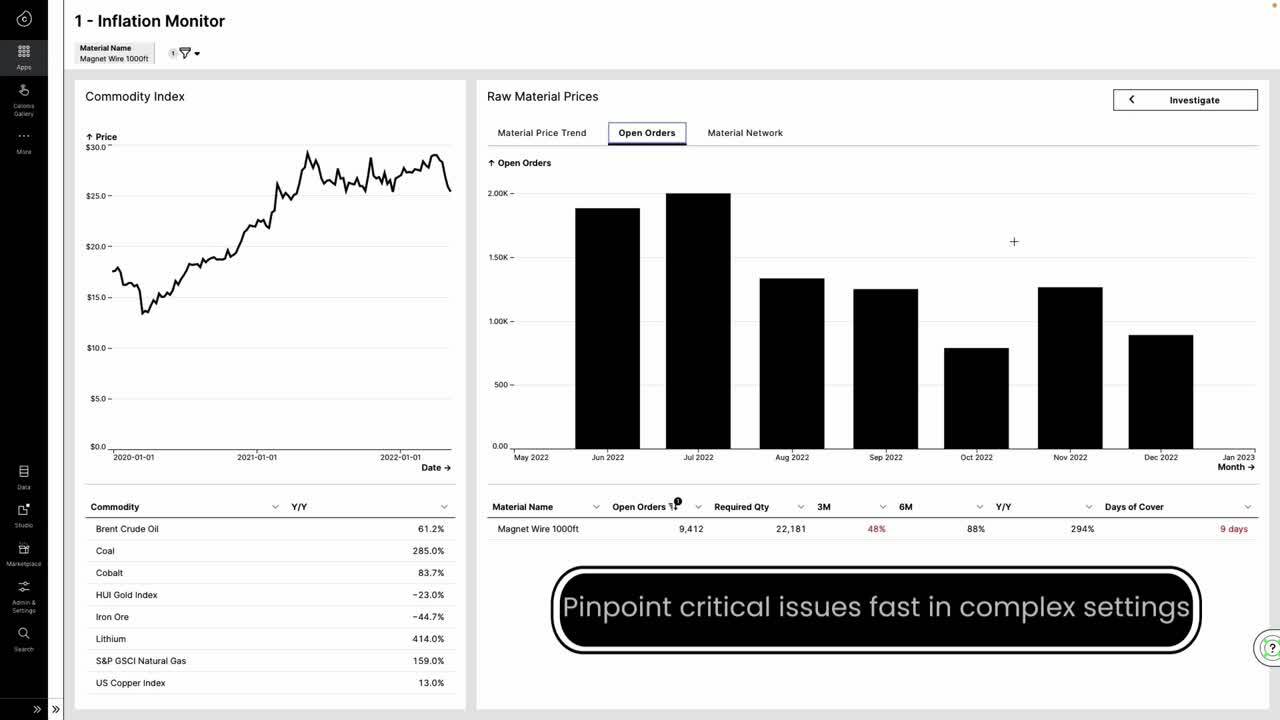
What is Procurement? The process and KPIs that matter
Procurement is a critical function amid supply chain disruptions, inflation and the need for ongoing cost management.
Here’s a look at the role of the procurement process and ways to continually improve to boost profitability.
What is Procurement?
Procurement exists to acquire the goods and services required by a business at the best possible terms. Traditionally, procurement and purchasing were seen as the same process. Over time, purchasing has become just one step in a larger procurement process that is increasingly strategic due to its ties to supply chain management and overall spend analysis. Today, effective procurement is critical given ongoing inflation and supply chain challenges.
A quick procurement overview
The procurement team is responsible for purchasing goods, identifying suppliers, negotiating contracts, and handling supplier relationships. As well as deciding what to buy, based on needs and budget, procurement must also ensure purchases deliver sufficient value. This often means aggregating demand and optimizing purchasing spend to minimize the amount spent for maximum value.
Where does Procurement fit in the process landscape?
At a high-level single process view, Procurement sits between Sourcing, which negotiates Procurement contracts and agreements with suppliers, and Accounts Payable, which processes and pays invoices. Procurement creates orders based on a company's demand. The two end-to-end processes that include Procurement are Source to Pay (S2P) and Procure to Pay (P2P).
Also see: 2023 Gartner® Magic Quadrant™ for Process Mining Tools | Press release
What is Procure to Pay?
It's a procurement process that includes the following steps:
Create Purchase Requisition (PR)
Create Purchase Order (PO)
Send Purchase Order to Vendor
Purchase Order Confirmation
Receive Goods
From there, Accounts Payable receives the invoice and pays it.
S2P end-to-end procurement processes include sourcing of goods, materials and services. Procurement management complements supply chain management, which revolves around the logistics of moving procured goods and distributing them.

What are the objectives of Procurement?
A procurement team has a lot of power to move a company's profit needle and have the following objectives:
Spend Reduction
Working Capital Optimization
Labor Productivity
Supplier Performance and Reliability
Ensure Compliance
Simply put, Procurement aims to spend less money for goods and services, manages cash flow by timing supplier payments well, processes orders efficiently, ensures on-time delivery and quality and prevents control violations. A procurement team also looks to automate processes whenever possible since the three components of a procurement process are people, process and paperwork that could be digitized.
Procurement is a process that's critical to understanding supply chains and increasingly sustainability initiatives.
E-book: Powering Procurement with Process Mining | More Procurement resources
What are the key Procurement metrics?
There are multiple metrics designed to track how Procurement meets business goals via process excellence. These metrics include:
Spend Reduction: Spend under management, total discounts taken.
Working Capital Optimization: Days Payable Outstanding.
Labor Productivity: Cost per PO, first time right.
Supplier Performane and Reliability: OTIF rate; Lead-time adherence.
Compliance and Sustainability: Spend compliance, Internal control failure and Carbon Footprint.
Moving the needle on these metrics can include continual improvement on duplicate payments, supplier consolidation, payment terms, accuracy, automation, delivery performance and fraud detection. In addition, Procurement departments can ensure process excellence by eliminating manual rework through automation, Process Mining and Execution Management.
Also see: Procurement Value Calculator | The State of Procurement Execution: Where Teams are Falling Short — and Why | Find and fix the inefficiencies in your Procure-to-Pay process What use cases are deployed by Procurement improvement teams?
There are dozens of use cases to improve Procurement processes, but here are five that businesses such as Deutsche Telekom Services Europe have utilized.
Procurement Contract Management and usage. Procurement departments often lack a clear overview of existing performance contracts and their usage and that can lead to increased spending. For instance, a company may be ordering the same materials from two vendors where one lacks a negotiated contract. By leveraging Process Mining, Procurement teams can identify materials and vendors where contracts aren't utilized and bring them into compliance.
Late Deliveries. Delayed deliveries of direct procurement materials can lead to expensive inventory holding costs. By detecting confirmed delivery dates or vendors that are frequently late, companies can eliminate late deliveries through automation, alerts and machine learning.
Touchless orders. Procurement teams can improve the automation rate of individual activities such as PO creation and goods receipt through process mining.
Free-Text Requisitions. Indirect procurement often involves the buyer spending time and effort researching materials and vendors. These requisitions can lead to match errors and unnecessary time spent. Machine learning can match free-text requisitions to past purchase orders to save time and money by reducing procurement tasks.
Maverick Buying. Buyers can purchase goods and services without the procurement department and miss out on discounts. Procurement teams can identify vendors and material POs frequently created after the invoice to curb rogue purchases.
What are the priorities for Procurement managers and executives?
According to a Deloitte 2021 Global Chief Procurement Officer Survey, 78% of respondents said driving operational efficiency was the top priority followed by 76.4% that cited reducing costs. For more data on correct purchase orders, supplier delivery reliability and spend under management see this Celonis infographic.
DownloadWhat are the ingredients of a Procurement organization?
According to research firm Gartner, there are three key parts to a Procurement department. They include:
People: Strategy, organization, design and talent.
Process: Category and contract management and strategic sourcing, supplier relationship management, supplier risk management and responsible sourcing and supplier diversity.
Technology: Procurement systems and IT that enables digital transformation and process excellence.
Why has Procurement become more urgent for companies?
Inflation is having a big impact on how Procurement is being viewed as a strategic function.
According to a Celonis webinar, "The Power of Procurement: Drive Agility and Manage Inflation Risk," Procurement leaders need to track material prices and shortages and availability of commodities and raw materials. Procurement teams also need to be agile to manage costs as well as orders with automation where appropriate.
Procurement professionals need to do the following to combat inflation:
Ensure supplier relationships are solid with efficient process execution for functions like pricing and discounts.
Keep in mind that KPIs related to cash are critical. Procurement strategies can help days sales outstanding, cash flow and working capital with analytics around payment terms with suppliers.
Look at global business processes standardization. Enterprises may have allowed processes and procurement policy to become fragmented across global units. Procurement efficiency and strategy can be improved by standardizing processes.
Leverage technologies such as process mining, automation, and artificial intelligence to improve Procurement systems.
What technologies can make Procurement more efficient?
For Procurement teams, Process Mining can grant a similar depth of process understanding as an explorative consulting exercise, and start delivering results in weeks instead of months. Plus, it’s always on and always available, providing ongoing visibility of process and performance blockers, instead of a single snapshot of performance.
Getting started with Process Mining is far simpler than many people expect. Data connectors pull data from your live systems into a process mining tool. From there you can add apps and connectors for specific analysis, and build your ideal view of process and KPI performance.
What is Process Mining? | Process Mining for Dummies | Process Mining: From Theory to Execution | Webinar: Process Excellence Unlocked: 5-Part Series on business and use cases
Execution Management can also automate tasks to fix issues. Execution Management is an emerging software platform to drive performance across multiple processes, industries and transformation initiatives. Execution Management orchestrates the digitization layer across multiple systems and data stores. These technologies complement existing Procurement Management Software systems in place at many enterprises.
What are Procurement challenges?
Procurement teams faced a bevy of ongoing challenges beginning with the COVID-19 pandemic. First, supply chain disruptions have continued, and Procurement departments are charged with managing the supplier and vendor base to build resilience. Due to inflation, the other key challenge facing Procurement teams is cost optimization. And finally, Procurement teams must manage risk and responsible sourcing to meet sustainability objectives.
To meet these challenges, Procurement teams will have to optimize processes continually and create strong supplier relationship management strategies.
Related:






